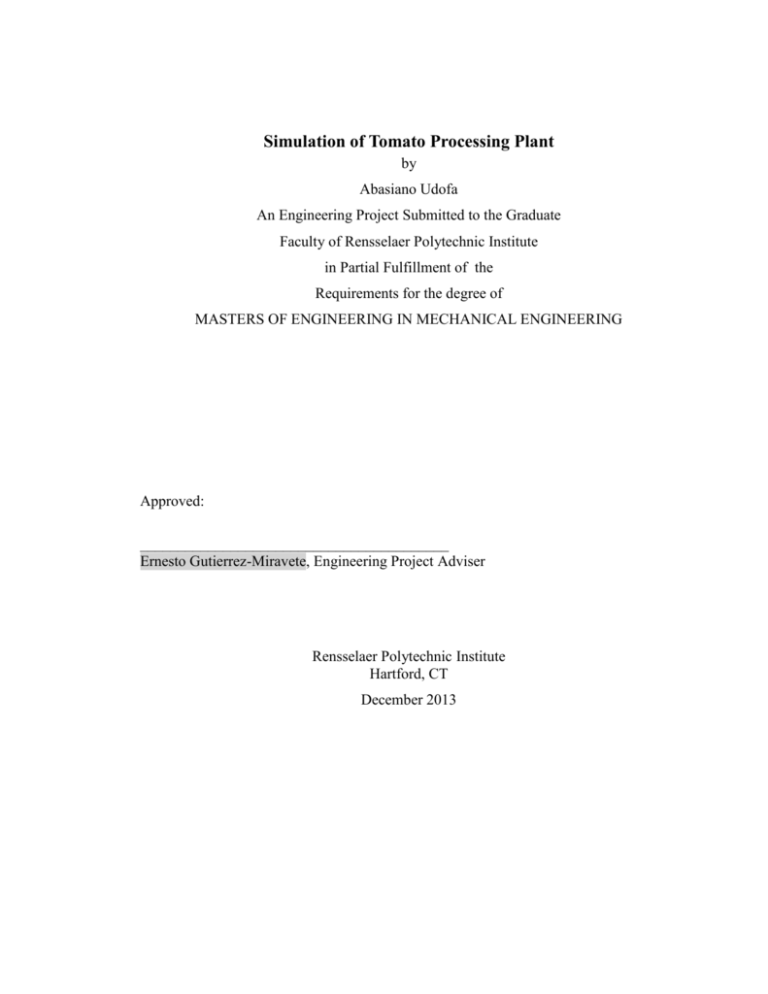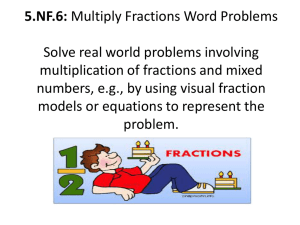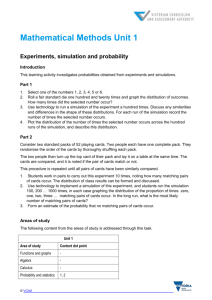
Simulation of Tomato Processing Plant
by
Abasiano Udofa
An Engineering Project Submitted to the Graduate
Faculty of Rensselaer Polytechnic Institute
in Partial Fulfillment of the
Requirements for the degree of
MASTERS OF ENGINEERING IN MECHANICAL ENGINEERING
Approved:
_________________________________________
Ernesto Gutierrez-Miravete, Engineering Project Adviser
Rensselaer Polytechnic Institute
Hartford, CT
December 2013
© Copyright 2013
by
Abasiano Udofa
All Rights Reserved
ii
CONTENTS
Simulation of Tomato Processing Plant ............................................................................. i
LIST OF TABLES ............................................................................................................ iv
LIST OF FIGURES ........................................................................................................... v
ACKNOWLEDGMENT .................................................................................................. vi
ABSTRACT .................................................................................................................... vii
1. Introduction.................................................................................................................. 1
1.1
Manufacturing Systems ...................................................................................... 1
1.2
Modeling Manufacturing Systems ..................................................................... 1
1.3
Tomato Processing Plant .................................................................................... 2
2. Methodology ................................................................................................................ 5
2.1
Mass Balance .................................................................................................... 5
2.2
Queuing Networks Theory .............................................................................. 1
3. Model Set Up .............................................................................................................. 1
3.1
Assumptions ...................................................................................................... 1
3.2
Locations ........................................................................................................... 1
3.3
Entities and Arrivals ........................................................................................ 2
3.4
Processing and Routing ................................................................................... 2
4. Results ......................................................................................................................... 4
4.1
Simulation Results............................................................................................ 4
4.2
Simulation vs. Hand Calculations................................................................... 2
5. Conclusions................................................................................................................. 3
iii
LIST OF TABLES
Table 1.1: Spreadsheet of Hand Calculations ............................................................... 1
iv
LIST OF FIGURES
Figure 1.1: Layout of the Tomato Processing Plant .......................................................... 4
Figure 2.1: Mass Balance for Tomato Processing Plant .............................................. 1
Figure 2.2: Layout of Locations ..................................................................................... 2
Figure 2.3: Location Utilization ........................................................................................ 1
Figure 2.4: Entity States of Tomatoes .............................................................................. 1
v
ACKNOWLEDGMENT
Type the text of your acknowledgment here.
vi
ABSTRACT
vii
1. Introduction
The purpose of this report is to demonstrate and discuss the modeling and analysis of a
tomato processing plant using Pro Model. The history, benefits, and advancements of
modeling manufacturing systems will be discussed along with a system overview of
tomato processing. A description of the models events, inputs, outputs, processes, and
resources required will be detailed.
Calculations will be performed analytically
determining arrival rates and throughput times for the system. These calculations will be
used to feed the model with inputs and a comparison of the analytical vs. actual rates
will be evaluated. The utilization
1.1 Manufacturing Systems
Manufacturing systems are processing systems where raw materials are transformed into
finished products through a series of operations performed at workstations.
These
systems consist of entities, activities, resources, and controls that define the parameters
for processing. Entities are the items being processed through the system. Activities are
the tasks being performed in the system. Resources are what is being used to perform
the activities. Controls dictate when, where, and how the activities are performed. The
resulting interactions of these elements are what make manufacturing systems complex
and difficult to evaluate. Interdependencies and variability are the two factors that make
up the complexity of manufacturing systems and make the behavior difficult to analyze
and predict. The manufacturing system under study in this paper is a tomato processing
plant.
1.2 Modeling Manufacturing Systems
Computation and simulation are the methods that have been used to try to model
manufacturing systems to understand the complexities and make responsible decisions.
Computation methods are extremely useful, but can be limited and inefficient with
larger, more complex systems. Simulation is a modeling and analysis technique used to
evaluate and improve dynamic systems of all types. Simulation is typically performed
on a computer utilizing various computer programs designed for capturing the behavior
of systems. Accurately predicting the performance of complex systems and having the
1
ability to test various scenarios before making major decisions that affect the system is
why simulation is important. Proper simulation accounts for interdependencies of a
system that cannot be obtained using other analysis techniques. This allows for risk-free
trial with no disruption to the current system and provides objective evidence to
substantiate changes to the system or guide in building a new system.
How simulation works is dependent upon the method of simulation chosen.
The
common ways of characterizing simulation are static vs. dynamic, stochastic vs.
deterministic, and discrete event vs. continuous. Static simulation is one that is not timedependent while dynamic simulation is dependent on time. Dynamic simulations are
well suited for service and manufacturing systems.
Deterministic vs. stochastic
simulation has to do with the nature of the inputs and outputs. Deterministic simulation
has fixed inputs and outputs, while stochastic simulation has random inputs and outputs.
Deterministic simulation will always produce the same outcome no matter the number of
run times. Stochastic simulation requires several runs to get an accurate performance
estimate due to variations of outputs for a given run. Discrete-event simulation is based
on the tracking of events as they occur at distinct times during the simulation, while
continuous simulation is based on the tracking of events as they change continuously
with respect to time. Discrete-event simulations typically reflect many manufacturing
and service systems. The simulation used for this project is dynamic, stochastic, and
discrete-event. These parameters best represent tomato processing plants due to the
change of state from solid tomatoes to tomato paste. Tomato processing plants are
process-oriented systems, which are represented by discrete-event simulation.
Pro
Model was the software chosen to complete this simulation. Pro Model is a powerful
commercial simulation tool that is designed to effectively model any discrete-event
simulation processing system.
1.3 Tomato Processing Plant
A tomato processing plant take fresh tomatoes and turns tns them into paste by
chopping, heating, and removing the water from the tomatoes. Tomato processing plants
are complex manufacturing systems. The tomato paste manufacturing system is a flow
2
line also known as a process layout. The tomatoes move along the same sequence shown
in figure 1.1.
3
Figure 1.1: Layout of the Tomato Processing Plant
4
2. Methodology
This section explains methodology used to calculate and predict the throughput time
and utilization of locations. This information will help to guide the building of the
simulation. A conservation of mass will also be shown for the tomato processing plant
to ensure that all material entering the system is accounted for. The hand calculations
will be used as a comparison to the outputs of the simulation.
2.1 Mass Balance
When building simulation models the first step is model conceptualization.
In
conceptualizing a tomato processing plant a mass balance is necessary to know how
entities are flowing through the plant. Although tomato processing plants change the
state of tomatoes to paste there still must be a conservation of mass. This model was
based on a plant that processes 1000 kg of tomatoes/day. This means 41.660 kg/hr are
being discharged into the system. One can assume that the tomatoes being discharged
were handpicked so we can expect ~2% waste between the receiving station and the
sorting station. The tomatoes next go to the chopping station then from the chopping
station to the hot break station. We can expect ~3% losses between the tomatoes going
from the hot break station to the evaporator. The evaporator station will evaporate ~84%
water at this station and the resulting paste will be sent to the aseptic filler. Figure 1.1
below shows a breakdown of the mass balance described above.
5
Figure 2.1: Mass Balance for Tomato Processing Plant
1
2.2 Queuing Networks Theory
Queuing networks theory is the basis for the calculations utilize to model the system.
Queuing networks provide good estimates for the characteristics addressed in simulation.
“Queuing theory is the science of waiting lines”. The tomato processing plant used
Poisson arrivals, exponential distributions, and first come first serve (FCFS) service.
Poisson arrivals are utilized because arrival times and service rates are stochastic,
probability distributions must be specified. The probability distribution for these
processes is the Poisson distribution. The distributions of interarrival and service times
are exponential. Exponential and Poisson distributions are so-called Markovian
distributions. FCFS service has been assumed for this type of system. The commonly
used abbreviation for queuing systems has the form A/B/s where “A” is the type of
interarrival distribution, “B” is the type of service time distribution, and “s” is the
number of servers. The tomato processing plant uses an M/M/6 queuing system. The
arrival rate is represented by (the service rate is represented byand the number
of servers represented by (c). The utilization factor () equals the arrival rate divided by
the number of servers times the service rate.
𝝆 = 𝝀/𝒄𝝁
[1]
Calculations were also based performed based on Little’s Law. Little’s law states the
expected number of entities in the system (L) is equal to the arrival rate (times the
throughput time (W).
𝑳 = 𝝀𝑾
[2]
where:
𝑾 = 𝟏/𝝁(𝟏 − 𝝆)
[3]
Open networks are systems consisting of multiple interconnected workstations typically
having jobs moving between pairs of stations according to some routing scheme. The
tomato processing plants consists of network workstations and was solved as an open
1
network. Open networks admit jobs from the outside world, which are then routed along
the network.
The following properties of stochastic systems are applicable to open networks.
1. The sum of independent Poisson RV is Poisson
2. If rates are Poisson inter-arrival times are Exponential
3. Inter-departure time from an infinite capacity M/M/c system is exponential.
The inter-arrival time (𝜆′) is defined by the arrival time multiplied by the probability of
the entity transferring to the next station (p).
𝝀′ = 𝝀𝒑
[4]
The three steps procedure used for analyzing this open queuing network are:
1. Determine effective arrival rates
2. Analyze each station as if it were alone
3. Aggregate the results over the network.
The expected throughput time is found by aggregating the results over the network.
𝑾 = 𝑾𝒋 𝝂𝒋
[5]
where:
𝝂𝒋 =
𝝀′
[6]
𝝀
A spreadsheet was created with the solutions of these steps and can be seen in table 1
below.
2
Table 2.1: Spreadsheet of Hand Calculations
Locations
Receiving
Sorting
Chopping
Hot Break
Evaporating
Packaging
Arrival Rate
10.00
Service Rate
12.00
12.00
12.00
12.00
12.00
12.00
Probability
1.00
0.98
1.00
0.97
0.16
1.00
0.03
0.84
Scrap
0.02
Eff. Arrival Rate
10.00
9.80
9.80
9.51
1.52
1.52
Utilization Rate
0.83
0.82
0.82
0.79
0.13
0.13
Aggregate
1.00
0.98
0.98
0.95
0.15
0.15
Throughput
Rate
0.50
0.45
0.45
0.40
0.10
0.10
Expected
Throughput
Time
0.50
0.45
0.45
0.38
0.01
0.01
1.80
L
5.00
4.45
4.45
3.81
0.15
0.15
18.01
1
3. Model Set Up
3.1 Assumptions
Many assumptions were made in the development of the simulation due to some of the
limits of the simulation software. The entities arriving to the system are assumed to be
in batches. The arrival time is 10 batches per minute. 1 batch contains 60 tomatoes,
which means that there are 600 tomatoes arriving into the system every minute. In
reality, there are multiple sorting stations and people monitoring and adjusting the
conveyor speeds for entrance into the plant. In model the assumption was made that
there is one sorting station and assumed a process time of 12 minutes. The processing
plant was design to process 41.67 kg/hr so the conversion was made to equal ~100
tomatoes/second. The service rates of the machines were assumed based on the desired
production output. In reality there is more variability with the service times of the
machines. The resources (water and steam) were not added to this model. There is an
added location called scrap where all the waste is routed within the system. In reality
there are flow lines that will route the scrap out of the system. Pro Model version xx
was used to model the system.
3.2 Locations
The model was built with seven locations. The figure below shows the layout with all
the locations.
1
Figure 2.2: Layout of Locations
The receiving, washing/sorting, and scrap areas were set up with a queue of infinite
capacity. The chopping, hot break, evaporation, and packaging locations were setup
with queue capacity of 12 each.
3.3 Entities and Arrivals
The only entities in the system are tomatoes. The tomatoes arrival time is 10
batches/min. Each batch contains 60 tomatoes. The receiving queue was set as infinite in
order to ensure that no tomatoes would be blocked from entering into the system, which
is how the plant would work in a real life situation.
3.4 Processing and Routing
The processing of the tomatoes is an intricate process involving complex machinery. For
the purposes of simulation, the only component utilized is the service time at each
machine for one tomato. An exponential service time of 0.5 minutes was utilized for
every station.
The routing is arranged for a serial flow through the system. It is
important to note that the routings account for the scrap during processing through the
probability command. From the receiving station to the washing/sorting station, 100%
of the entities were successfully processed. From the washing/sorting to chopping
2
station, 98% were successfully routed through the station while the remaining 2% sent to
scrap. From the chopping station the hot break station, 100% of the tomatoes were
successfully routed through the system. From the hot break to evaporation station 97%
of the entities entering were routed while 3% were sent to scrap. From evaporation to
packaging station 16% are routed to be packaged while 84% were sent to scrap. The
84% consists of all the water that is removed for the paste to be made.
3
4. Results
The following section will discuss the results based on the simulation location and
entities statistics. The section also includes recommendation for future optimization of
modeling and tomato processing plants. The discussion ends with a comparison of the
simulated resulted to the hand calculations for accuracy of predictability.
4.1 Simulation Results
Figure 1 shows the utilization for each of the locations in the tomato processing plant.
The receiving and washing/sorting locations are fully occupied while the chopping, hot
break, and evaporation locations are approximately 62%-64 % occupied. The scrap and
the packaging locations are where the entities exit the simulation so the locations are
empty in the figure below.
4
Figure 2.3: Location Utilization
1
Figure 2.4 shows the entity states for the tomatoes. As illustrated, the majority of the
tomatoes are in the receiving and washing/sorting queue waiting to be processed. All of
the other locations indicate that some percentage of the queue is empty while the
receiving and washing/sorting locations are fully occupied.
For further optimization of the system, one may consider increasing the queue capacity
or adjusting the service times of the chopping, hot break, and evaporation locations in
order to increase production at these individual locations which will in turn increase the
overall production of the system.
Figure 2.4: Entity States of Tomatoes
1
4.2 Simulation vs. Hand Calculations
2
5. Conclusions
The simulation model accurately depicts a tomato processing plant and can be utilized to
make predictions for the many uncertainties that could arise from variability and
interdependencies of the tomato processing plant, be they malfunctioning machines or
late tomato deliveries.
Simulation, in comparison to “trial-and-error” techniques is an effective tool as it
simplifies the complexities of the system. For example, simulation depicts behavior over
time and multiple performance measures. This information may be used to guide the
decision making process and undoubtedly benefits the tomato processing companies.
3










